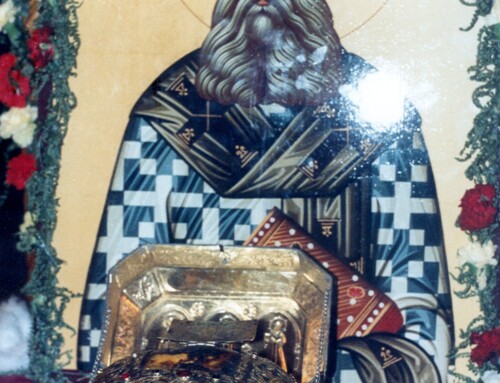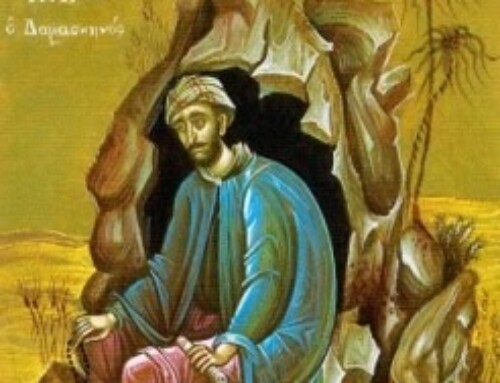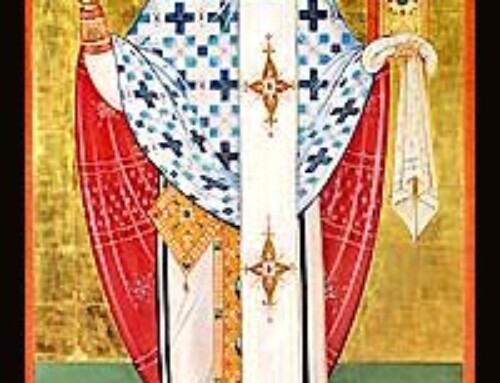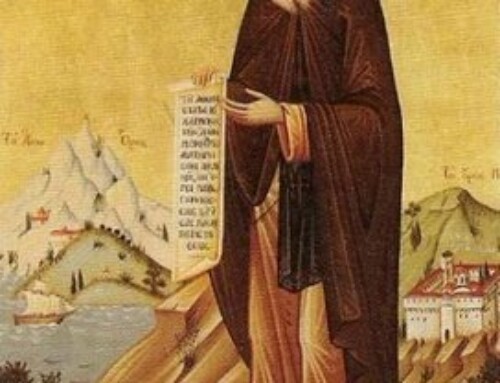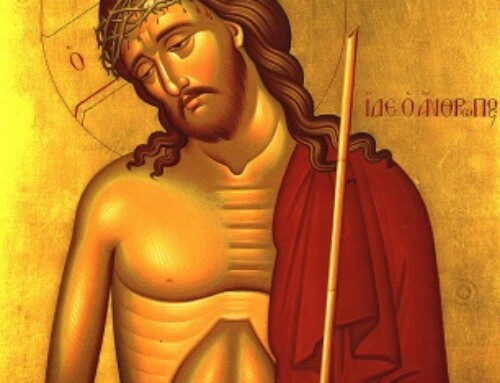Presentation By Father Paul Albert
Midwest Region Clergy Seminar
Terre Haute, Indiana
CATECHESIS AND TEACHING MINISTRY IN THE PRIESTHOOD
“. . . Thou hast brought us up to heaven and hast endowed us with Thy kingdom which is to come…”
The Illumining Light of Holy Tradition through participation in Orthodox Christian Prayer, Worship and Mysteries
Given at the Clergy forum at the Spring Meetings in Terre Haute, IN on March 14, 2002
I. Introduction: Theoria and Praxis
A. John 1:46
1. The Apostle Nathaniel’s cynicism: “Can anything good come out of Nazareth?”
2. The Apostle Philip’s invitation: “Come and see” (John 1:46)
B. In his ministry of teaching and preparing the catechumens, it is easy for the priest to fall prey to cynicism that discourages thorough preparation of those seeking to enter the Church.
1. It becomes imperative for us that our churches be truly a place where Life in Christ can be witnessed, encountered and participated in by our catechumens.
C. As pastors, we know that the Catechumanate does not culminate in Baptism and/or Chrismation.
1. We encourage the faithful in understanding that this particular ministry needs be seen more as a long term “adoption process”.
2. It is initiated with the Priest, but the entire parish family in Christ makes a lifelong commitment.
3. The movement of an individual into the Body of Christ is a response to the hunger within the human soul for refuge, for healing, for restoration.
D. The ongoing participatory aspect of catechesis is illumined by Our Lord’s parable of the Good Samaritan.
1. And when he saw him, he had compassion. So he went to him, and bandaged his wounds, pouring on oil and wine: And he set him on his own animal, brought him to an inn, and took care of him. On the next day. when he departed, he took out two denarii, gave them to the innkeeper, and said to him, ‘Take care of him; and whatever more you spend,
When I come again, I will repay you (Luke 10:33-35).
2. Our Icons of this parable are harmonious with the Patristic interpretation that the two coins are the two Testaments, as Christ, the “author and finisher of our faith” (Heb 12:2) is seen entrusting two scrolls to the “innkeeper”, His chief Apostles, Peter & Paul, who are seen standing in the midst of the Church.
3. Intrinsic in all activity of prayer, worship and the Sacraments, is the veneration of the Bible: solemn reading of scripture, constant repetition of the Psalms, in our daily conversation, “speaking to one another in psalms, hymns and spiritual songs. “(Eph 5:19)
a. That first “coin”, The Old Testament, “having a shadow of the good things to come, and not the very image of the things” (Heb 10:l) is still the indispensable typological language, a richly unique literary Iconography, woven completely into our Tradition, in particular, throughout all the offices of our Divine Services.
b. The Old Testament is completed, fulfilled, illuminated in the light of the New Testament. This “second coin” to which the Good Samaritan entrusts us, the other scroll in the Icon, is founded upon the Incarnation of God in the flesh (Galatians 4:4-7).
4. The catechumen comes to understand that within the Church, the very process of this adoption, the essential colour of this New Covenant, is incarnational, and is now realized within us (Heb 8:8-10; ref. Jer. 31:33).
5. These two “coins” of the Parable bear the image of God Transcendent and God Incarnate; the God beyond all our experience, and the God Who fills all things with Joy, for He has come to save the world!
6. It is in this light that we can instill the utmost and profound respect, in the heart of the catechumen, for the steadfast authenticity of our Holy Tradition as a legitimate, living and holy participation in the kingdom of God.
7. St. John Chrysostom’s homily on the Good Samaritan reveals the use of oil and wine as salvific:
a. “by mixing the Holy Spirit with His blood, He brought life to man…
b. oil brings the comforting word,
c. wine produces the astringent lotion, the instruction which brings concentration to the scattered mind.”
8. the two coins may also be analogous with the two great components of Orthodox Catechesis: theoria and praxis.
a. Both have been entrusted to the Church
b. the clergy, as “innkeeper”, utilize these two treasures as the means to sustain the Catechetical ministry of healing to those brought to us (by Christ, Who is the Good Samaritan).
c. These two coins, impressed with the likeness of both the Divine and human natures of our King, remind us of the inseparable, interdependent wholeness of theoria and praxis.
d. These two go “hand in hand” as we minister to the catechumen, and, more importantly, to our entire parish. “Let us kindle for ourselves the light of knowledge. This will be done by sowing unto righteousness, and reaping the fruit of life, for praxis is the patron of theoria. . .” St. Gregory the Theologian (Oration 40:37).
e. To paraphrase St. Maximus the Confessor: praxis is not safe without theoria, nor is theoria true without praxis. Our praxis must be intelligent, and our theoria must be efficacious
9. St. Neilos: “The Tradition of the Church is a living reality, which the Orthodox Christian must live daily in a mystical way. By adhering to the teaching of the Scriptures, the Patristic writings, and Ecumenical Councils, by observing the canons of the Church, by frequently participating in the Prayer life, Worship, Sacraments, and especially the Eucharist, where Tradition becomes an empirical reality, we are members of the Body of Christ and are led to the ‘contemplation of God.’”
II. Participation as life in the Kingdom
A. Preparation: Apostolic encounter
I. What brings enquirers to our doors?
a. Realization that there is more to being a Christian than just the Bible
b. A calling to find the living link to New Testament Christianity
c. Awareness that “I need the Church”
d. Desire for an “incarnational” relationship with God; One’s hunger for true, prayerful encounter with God
2. “Philip found Nathaniel and said to him, “We have found Him of whom Moses in the law, and also the prophets wrote-Jesus of Nazareth, the son of Joseph. “(John 1:45)
a. Philip’s ZEAL is his witness, bringing his friend to the Lord
b. He brings his friend to a person, to his salvation, to his Savior
“Therefore, a true witness of Christian life is the fire of active zeal for pleasing God. Now the question arises, how is this fire ignited? Who produces it? Such zeal is produced by the action of grace. However, it does not occur without the participation of our free will.. .the divine life is aroused when the Spirit of God penetrates into the heart and places there the beginning of life according to the Spirit, and cleanses, and gathers into one, the dark and broken features of the image and likeness of God. A desire and free seeking are aroused (from an action from without) then grace descends (through the Mysteries) and, uniting with our freedom, produces a mighty zeal. But let no one think that he himself can give birth to such a power of life; one must pray for this and be ready to receive it. The fire of zeal with power-this is the grace of the Lord. The Spirit of God, descending into the heart, begins to act within it with a zeal that is both devouring and all active.” (St. Theophan the Recluse: The Path to Salvation, ch. 1)
3. The process of catechetical instruction is one of gradual assurance that the Orthodox Christian path is true.
4. It is important for the Catechumen to “see” that the goal of all of this leads to Sacramental Initiation: nothing less than becoming a temple of the Holy Spirit, and entering communion with the Saints!
a. Life in the kingdom is synergistic
b. Through the cooperation between divine grace and the human will, the mind and heart can be purified, the soul can find restoration to its original beauty, and one can approach communion with God!
B. Preparation: Liturgical prayer as conversation with God
1. A challenge of this present part of the process of Catechesis is one of right-relationship.
a. With God
b. With significant others in the Church
2. Sometimes the catechumen comes to realize that the journey towards something (i.e.: the Orthodox Church) means also a departure from something.
a. The catechumen undertakes a perilous journey where many life-long assumptions will be challenged, and particular ways of doing things will (sometimes sadly) be left behind.
b. It is precisely at this early stage of catechetical process that it is wise to encourage relationships with sponsors and mentors in the parish family.
i. It must never be underestimated, the importance of this image of Philip walking arm in arm (as was the custom) with his friend Nathaniel to meet Christ!
ii. We all need, in this stage of our journey, to feel a sense that others will be with us to lean upon
3. Preaching and teaching the faithful about the intensified focus of prayer for the Catechumens during Great Lent (especially during the Presanctified Liturgies) will further help our faithful in taking a more proactive role with those preparing to join our Body in Christ.
4. In better understanding the particular sins besetting our culture today, the priest develops more patience and compassion for the catechumen who is on the very difficult path of purgation and purification.
a. Nathaniel moved through a trying process: from open cynicism to faith.
b. The catechumen may be coming to the Church (from a secular milieu) after a life of self-direction, self-will, and self-confidence.
c. Spiritual direction, our tradition of spiritual warfare, and a right relationship in Sacramental Confession can be terrifying, especially if trust has been a long-standing issue.
d. The groundwork we do, preparing the catechumen in right relationships, will be an investment for the person’s lifelong fidelity to the Faith and the Sacraments.
5. The ongoing development of relationship with their priest as spiritual father, confessor, and director is important.
6. As the Catechumen enters into the practices of our holy Tradition, it can seem miraculous with what penetrating and discerning light our Faith begins to reveal (maybe for the first time) the path to true personhood, renewing the relationships with God and others.
a. “Faith is not a matter of mere understanding. . .through study. Faith, as trust in God and abandonment of oneself to Him, is closely related to love, which is God Himself. When you love, when you offer as much as you can give to others, to your brother – to Christ – and end up by offering your very self to God, then you know Him: you believe. . . Then you feel that your whole being embraces an inexpressible exultation and blessing which is a spring of incorruption. . .you are flooded with an inexhaustible longing to sing praises and give thanks to God who is love, all-wise, all powerful, eternal, inscrutable…” (Archimandrite Vasileios, Hymn of Entry)
b. “The life and character of an Orthodox Christian is in large measure shaped, nourished, and enriched by the liturgy or worship of the Church. Replete with biblical readings, imagery, and expressions, the texts of the liturgy set forth in doxological form the Church’s authentic and living tradition. In the liturgy, the Orthodox Christian is in constant touch with the fundamental truths of the faith.” (Bishop DEMETRI’s outline)
c. What might start as the individual’s awaking to personal self-knowledge will also quickly open into an awareness of collective identity in corporate body of prayer and worship
d. “Seest thou these venerable arrangements of the Church? Viewest thou her order and discipline, the reading of Scriptures, the presence of the religious, the course of teaching? Let then the place affect thee, let the sight sober thee.” (St. Cyril of Jerusalem, On the Christian Sacraments)
7. In all the practices of our Faith, both personal and corporate, the catechumen both anticipates and begins to taste of an experience of encounter with Christ in a new way, in a new “light”.
a. It is highly personal, and yet, the catechumen finds freedom from self-directed emotional expectations
b. Prayer is now fervently channeled through the conduit of structure and discipline in a new spirit
c. The whole person is being integrated into the Body of Christ.
d. 2 Corinthians 5:17-20
8. Through purifying spiritual disciplines, including participating in the Church’s cycles of prayer, the individual is restored into the Light, Who is Christ.
9. The Catechumen appreciates that Orthodox Christians have been endowed with a particular gift of perceptiveness of the BEAUTY of God’s kingdom (both the visible and spiritual).
a. This apprehension of BEAUTY is richly expressed through our worship, sacred arts, prayer, and Sacraments.
b. in all areas, the Catechumen should be guided to a deeper appreciation of the particular “otherworldliness” of our experience (2 Corinthians 4:18)
10. Through the Church’s authentic and living Tradition of Prayer, worship and Sacraments, Christ speaks to the catechumen.
a. Most assuredly, I say to you, hereafter, you shall see heaven open, and the angels of God ascending and descending upon the Son of Man.”
b. (John l:5l)
11. The Catechumen preparing to “come home” into the Sacramental Illumination and Initiation into the Mysteries of the Church
C. Initiation: Participation in the Sacramental Mysteries as life transfigured
1. “Now, therefore, you are no longer strangers and foreigners, but fellow citizens with the saints and members of the household of God, having been built on the foundation of the apostles and prophets, Jesus Christ Himself being the chief cornerstone, in whom the whole building, being fitted together, grows into a holy temple in the Lord, in whom you also are being built together for a dwelling place of God in the Spirit” (Eph. 2:19-22, NKJV)
2. The powers of the Kingdom already experienced in the Church are manifested through the divine mysteries or sacraments offered in faith.
a. In the Eucharist, all Orthodox Christians meet together and in absolute agreement, in doctrine and practice witness the presence of the Holy Trinity on the altar of the Church.
b. The bishop and the priest pray to God the Father to send the Holy Spirit and transform the bread and wine into the very body and blood of Christ.
c. All the faithful present arc called to receive Communion and become active members of the Body of Christ.
d. “The cup of blessing which we bless, is it not the communion of the blood of Christ? The bread which we break is it not the communion of the body of Christ? For we, though many, are one bread and one body; for we all partake of that one bread” (1 Cor.10:16-17, NKJV)
i. The Greek koinonia from the above text of 1 Corinthians, here translated as “communion” can also mean: fellowship, a close mutual relationship, participation, and partnership
ii. St. John Chrysostom dwelt upon this word as “participation” in his homily upon the text.
i. The word means more than “sharing or partaking.”
ii. It is participation through UNION
iii. It is lamentable that this word, “participation” in English is often reduced to a utilitarian noun.
i. We can say that “participation” in the Sacrament of Holy Communion is considerably different than “participation” in a post-season football game
ii. Those who receive a share of the Body of Christ become the Body of Christ
iii. Orthodox practice involves veneration, meaning ‘original participation’ with the prototype
1. participation through union
2. “He who has seen the uncreated light and united with God is not awaiting the Second Coming of the Lord, but living it.” (St. Symeon the New Theologian)
iv. As we recover the great JOY of the Catechumen’s exodus from this world into the Paschal Light and PARTICIPATION in that heavenly Banquet, this will carry more and more of our faithful towards true spiritual renewal in their own sacramental PARTICIPATION.
3. The challenge will always be to form a spirit within the faithful that our personal reasons for gathering are subjugated to our mission: gathering to become and witness the Body of Christ.
4. Christ’s mission in the world is furthered precisely as we achieve personal “transparency,” revealing Christ in our midst
a. This idea could perhaps shape a whole line of approach to catechism, emphasizing the importance (mission) of building up a healthy, interdependent “praying core” in the community, where we spend our days praying for peace and repentance
5. The pastor, in his teaching ministry should develop an approach that addresses the real issues confronting the modern “mind” in its regard to sin.
i. establish an understanding that self-knowledge is the essential component for progress in the path of holiness
ii. “if we say we have no sin, we deceive ourselves, and the truth is not in us. “(1 John 1:8)
iii. St. Peter of Damascus instructs us: “knowledge of our own faults and of God’s bounty is theoria.” (Philokalia v.3, p.108)
6. It takes tremendous patience and faith in order to help maintain an atmosphere of piety and sobriety in the parish
a. It needs to become increasingly evident to those entering our parish that this is a place where we are in the process of finding salvation
b. Our practices, as “good stewards of the Mysteries of God” (1 Cor 4:1) bring forth true knowledge of who we really are, and just Who God is
7. The catechumen needs to realize that this process of purification, in order to attain communion with God, is continuous, and healing is endless
a. emphasis must continue to be upon building an Orthodox worldview, which affirms the many ways we are saved together in the Body of Christ
b. Personal conversation with God is not enough
i. Praying to God and privately confessing one’s sins alone can certainly lead to a self-deceiving satisfaction, or imagining everything to be fine
c. The work on ourselves, the work of Confession and spiritual direction
should be taught as essential and ongoing process.
d. True tears of repentance cleanse the nous, the intellect dwelling in the depths of the soul
e. Communion means for us that we are, at last, a “real” person, and can begin a life transfigured in the likeness of God
f. Ephesians3:14-19
Summary texts:
D. “… as His divine power has given to us all things that pertain to life and godliness, through the knowledge of Him who called us by glory and virtue, by which have been given to us exceedingly great and precious promises, that through these you may be partakers of the divine nature, having escaped the corruption that is in the world through lust. “(2 Peter 1:3-4, NKJV)
E. St. Paul’s prayer for his spiritual children is our prayer for the Catechumens (Colossians 1:9-23, NKJV)

